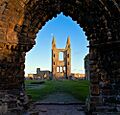Patrick Adamson facts for kids
Quick facts for kids Patrick Adamson |
|
|---|---|
| Archbishop of St Andrews | |
| Church | Church of Scotland |
| Archdiocese | St Andrews |
| In Office | 1575–1592 |
| Predecessor | John Douglas |
| Successor | George Gledstanes |
| Other posts | Primate of Scotland |
| Orders | |
| Consecration | 1576 |
| Personal details | |
| Born | March 1537 Royal Burgh of Perth, Scotland |
| Died | 10 February 1592 (aged 54) St Andrews, Scotland |
| Nationality | Scottish |
| Denomination | Presbyterian |
| Spouse | Elizabeth Arthur |
| Children | 3 |
| Alma mater | University of St Andrews |
| Coat of arms |  |
Patrick Adamson (1537–1592) was an important Scottish religious leader. He served as the Archbishop of St Andrews starting in 1575.
Contents
Early Life and Education
Patrick Adamson was born in March 1537 in Perth, Scotland. His father, also named Patrick Adamson, was a respected citizen and a leader in the merchant community there.
Adamson went to the University of St Andrews to study philosophy. He earned his Master of Arts degree and later received a doctorate, showing he was a very smart student.
Time in France
After working as a minister in Ceres, Fife for three years, Adamson traveled to Paris in 1565. He became a tutor for the oldest son of Sir James MacGill, a high-ranking Scottish official.
Poem for Prince James
In 1566, Adamson wrote a poem in Latin for Mary, Queen of Scots and her husband, Henry Stuart, Lord Darnley. The poem celebrated the birth of their son, Prince James. Adamson described Prince James as a future ruler of "France and England."
This part of the poem caused problems when it was shared with the French court. It suggested that Prince James had a claim to the French throne, which upset the French King, Charles IX of France. Adamson was held in France for six months because of this. He was only released after Queen Mary and other Scottish nobles helped him.
Studying Law in Bourges
After being released, Adamson and his student moved to Bourges, France. There, Adamson continued his studies, focusing on law at the University of Bourges.
During his time in France, a terrible event known as the St. Bartholomew's Day Massacre happened in Paris in 1572. This was a period of great danger for Protestants. Adamson had to hide for seven months in a tavern in Bourges to stay safe.
Returning to Scotland
In 1572, Adamson returned to Scotland. He became a minister in Paisley. In 1575, he was chosen by the General Assembly to help decide how the church should be organized and governed.
The next year, Adamson became the leader, or Moderator, of the General Assembly. He and another leader, David Lyndsay, presented the church's decisions to Lord Morton, who was ruling Scotland at the time.
Becoming Archbishop
In 1576, Adamson was made Archbishop of St Andrews. This decision led to a long disagreement with some members of the church who preferred a different system called Presbyterianism.
Adamson had already written a religious book in Latin verse for King James VI. Even his opponents praised this work. He also translated the Scots Confession of Faith into Latin.
Challenges and Later Years
Adamson faced many challenges during his time as Archbishop. In 1578, he appeared before the General Assembly to answer questions about his role. He got a short break from the accusations, but new ones came up the next year.
During these difficult times, he found safety in St Andrews Castle. It was said that a woman named Alison Pearson, who was later accused of witchcraft, helped him recover from a serious illness.
Ambassador to England
In 1583, Adamson took on a public role again. He was sent as the Scottish ambassador to the court of Elizabeth I of England in London. While he was there, some rumors spread about his behavior.
When he returned to Scotland, Adamson supported strong laws in the Scottish parliament against Presbyterians. Because of this, he was accused of heresy and removed from his church position at a meeting in St Andrews in 1586. However, this decision was later overturned by the General Assembly.
Final Years and Legacy
More accusations were made against Adamson in 1587 and 1588, and he was again removed from his position. Later, with the help of a former opponent, Sir Andrew Melville, his sentence was canceled.
Adamson continued to write, creating Latin verse versions of the Book of Lamentations and the Book of Revelation. He dedicated these works to the king, but also complained about how he had been treated. King James was not moved by Adamson's pleas. The king gave Adamson's church income to his new favorite, Ludovic, 2nd Duke of Lennox.
Adamson spent his last three years relying on charity for support.
Adamson was known for being very smart and a good speaker, but he also had some character flaws. A document called the "Recantation of Episcopacy" (1590), which claimed he gave up his beliefs, is likely not real. His collected writings were published in 1619 by his son-in-law, Thomas Wilson. The book praised Adamson, saying he was "a miracle of nature."
A special heraldic memorial to Adamson can still be seen at the old St Andrews Cathedral.
Family Life
Patrick Adamson was married to Elizabeth Arthur. They had two sons, James and Patrick, and a daughter named Mariota. Mariota married Sir Michael Balfour.
Patrick's older brothers, James and Henry, both served as the chief official, or Provost, of Perth. James was the father of Henry Adamson, and Henry was the father of John Adamson.
Images for kids
-
Cathedral of St Andrews, Fife


